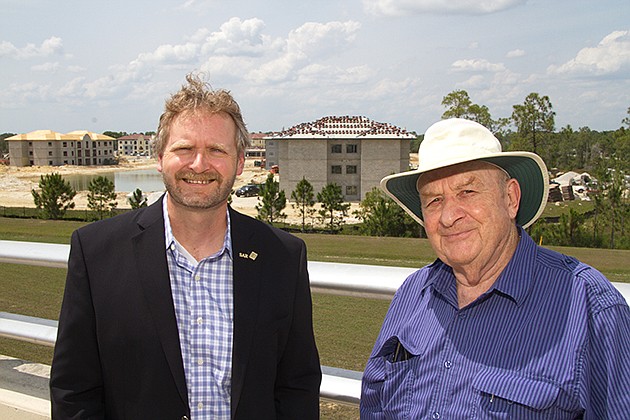- November 25, 2024
-
-
Loading

Loading

This is as close to a crystal ball as you can get.
Paul Van Buskirk and David Farmer have developed a population-growth forecasting model that has proven to be spot on, and now the two entrepreneurs have teamed up to form a company in Bonita Springs called Metro Forecasting Models to take the model to other fast-growing areas of the country.
The data is hugely valuable to commercial developers and municipalities because it can help them plan for future growth. What's more, it can alert developers of dangers ahead. “We can warn ahead of time when we're overbuilding,” says Farmer, who previously was a land-development consultant in Naples.
Van Buskirk is a longtime forecaster in the region who developed a population-forecast model based on the mathematical formula of 19th Century Belgian mathematician Pierre-François Verhulst. While doing research, Van Buskirk found Verhulst's formula and discovered that the mathematician had accurately forecast the 1940 U.S. population 100 years earlier (he was off by just 1%).
Van Buskirk has been a keen observer of Florida's population boom. He moved to Florida in the late 1970s and worked for General Development Corp., one of the state's largest developers of communities such as North Port and Port Charlotte.
While the mathematical formula is complex, Van Buskirk explains his forecast model this way: Imagine you have a jar with yeast growing inside it. The yeast grows exponentially until it fills the jar. Van Buskirk says Florida's population grows much the same biological way.
By contrast, many forecasters use a less accurate method using estimates from the U.S. Census and extrapolating them in a straight line, Van Buskirk says.
But these linear methods don't account for land use. Much like the volume of a jar limits the yeast's growth, Metro Forecasting uses the availability and zoning of land to cap the growth. “Our method tells us when it's built out,” says Farmer.
Van Buskirk's formula has proven extremely accurate over time. For example, in 2002, he forecasted that the 2010 population of Cape Coral would hit 155,179 permanent residents.
When the U.S. Census published population figures in 2010, Van Buskirk had scored the equivalent of a demographic bull's eye: Cape Coral's population was 154,305 in 2010. He was off by just 874 people, or 0.56%, U.S. Census figures showed.
Metro Forecasting breaks down each county into thousands of parcels so that it can estimate whether commercial space or residential development is appropriate for any parcel. For example, the company estimates Lehigh Acres' future population growth could absorb three times the amount of commercial development that's available now, and Metro Forecasting can identify the right locations.
While Metro Forecasting charges a custom price on its work, the owner of a parcel might pay $2,500 for an analysis. “We want to help people make a lot of money,” Farmer says.
Municipalities can benefit from this information, too. Once they've established population models, Metro Forecasting can build more sub-models to identify where schools, parks, water and sewer plants should be located and how much stormwater runoff could result from new-home construction, for example. “The model can now forecast all this stuff,” says Farmer.
Now Farmer and Van Buskirk have refined software that can build models more efficiently. Van Buskirk estimates the software represents a $500,000 investment over time and both he and Farmer said they might license it one day. “We're open to a lot of different things,” Farmer says.
For now, they're building population-forecast models in Sarasota County for three areas: North Port, the city of Venice and the city of Sarasota. “We're pulling data for Manatee County,” Farmer adds.
In addition, Metro Forecasting is starting to build models for other areas of the country, including North Carolina and Alabama as well as western states. Farmer and Van Buskirk estimate they can now produce seven models a year. Software and data collection is more efficient than it used to be. “We're reducing the cost to produce the models,” Farmer says.
Follow Jean Gruss on Twitter @JeanGruss